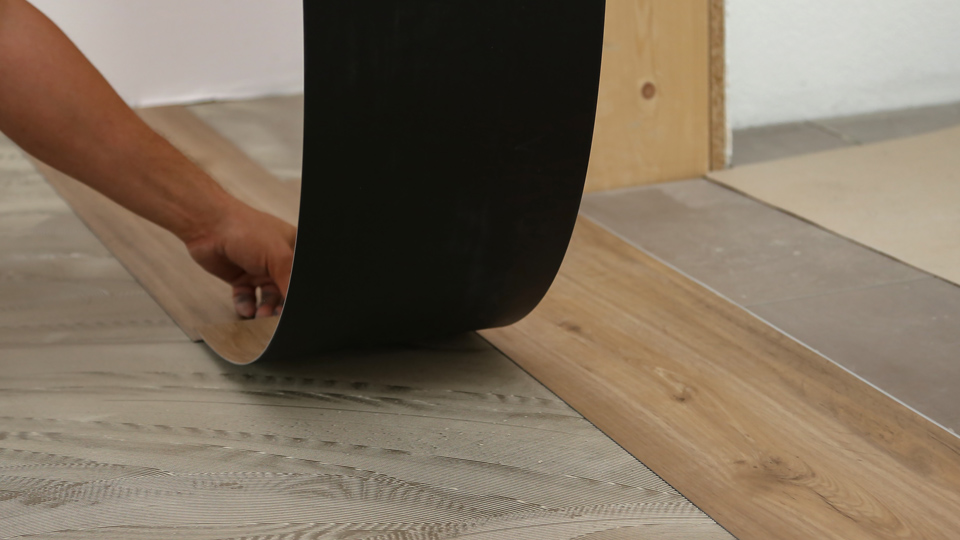Vinyl and laminate flooring are popular choices with distinct differences.
Vinyl, crafted from synthetic materials like PVC, offers options like sheets, tiles, and luxury vinyl planks.
Installation comes in glue-down, click-lock, and peel-and-stick forms, making it DIY-friendly. Comparatively, laminate consists of layers, featuring a high-density fibreboard core and a decorative top layer imitating wood or stone.
While laminate often employs a click-lock system for installation, it may require underlayment. In costings, vinyl is generally more budget-friendly, making it a cost-effective option. Durability-wise, vinyl excels in moisture resistance, scratch, and dent resistance.
Aesthetically, both materials mimic natural elements, with vinyl being softer and more comfortable underfoot.
Vinyl and laminate are both popular choices for flooring materials and they have some key differences:
Buying and Fitting Laminate vs Vinyl
You’ve finally decided to take the plunge and change the flooring in your room. You know you want it to be budget friendly but you’re still not sure whether to use vinyl or laminate.
We highly recommend getting out into the stores and feeling the materials. That way you’ll get a real life view of what it might be like in your room. If you don’t fancy going to a store, try getting some samples online and check how they look in different corners of the room – some dar areas and some light areas.
Though you still unsure whether to use ViWhether it be the kitchen, lounge or even bedroom
Material
Vinyl flooring is made from synthetic materials, primarily PVC (polyvinyl chloride), and can come in various forms, including vinyl sheets, vinyl tiles, and luxury vinyl planks (LVP).
Laminate flooring consists of multiple layers, typically including a core layer made of high-density fibreboard (HDF) and a decorative top layer that mimics the appearance of wood or stone.
Installation
Vinyl flooring is available in various installation options, including glue-down, click-lock, and peel-and-stick. It is typically easier to install and may be suitable for DIY projects.
Laminate: Laminate flooring is often installed using a click-lock system, which is also relatively easy for DIY installation. Some laminate floors may require a laminate underlay.
Vinyl vs Laminate costings Compared on a 4m x 4m (16m2) room
Determine the Price Per Square Meter in Pounds: In this example, it’s £15 per square meter.
Calculate the Total Cost: Multiply the price per square meter by the room area (20m²):
Total Cost of Vinyl Example = Price Per Square Meter × Room Area Total Cost = £15/m² × 16m² Total Cost = £300
-
-
- Vinyl flooring is generally more budget-friendly compared to laminate, making it a cost-effective choice for many homeowners.
- Laminate: Laminate can be more expensive than vinyl, particularly for high-quality, realistic wood-look options.
-
Longevity & Maintenance
How long you want it to last is going to be a key decision for you.
Is this a temporary ‘fix’ before a full reno or a long term decision? Either way, understanding how long each flooring will last can help you make the final decision on what’s best for you.
Vinyl vs Laminate Durability
- Vinyl is known for its durability and resistance to moisture, making it suitable for areas prone to water exposure like kitchens and bathrooms. It’s also resistant to scratches and dents.
- Laminate is durable but can be more susceptible to moisture damage if exposed to water for an extended period. It is also less scratch-resistant than vinyl, so it may show wear over time.
Maintenance
- Vinyl is low-maintenance and easy to clean. Regular sweeping and occasional mopping are usually sufficient to keep it looking good.
- Laminate requires regular sweeping and occasional damp mopping. However, it’s important to avoid excessive moisture to prevent damage.
Overall, laminate flooring is more likely to be damaged by water or moisture than vinyl. Vinyl is often chosen for the kitchen for this reason. The constant change in temperature from cooking, back door opening and heavy usage, make vinyl the perfect longer term option. Laminate on the other hand is probably more of a temporary measure. For example, if you plan on doing a more expensive refurb in the future, you might just want a nice cheap laminate to get you by until then.
Aesthetics
Comfort and Sound – is there even a difference
When we talk about comfort, we can look at various factors. These include warmth on the feet, noise absorption and the density of the surface.
Vinyl: Vinyl flooring tends to be more comfortable underfoot and quieter than laminate, as it has a softer surface.
Laminate can be noisier and less comfortable to walk on because of its harder surface.
Appearance
-
- Vinyl: Vinyl flooring can mimic the look of hardwood, stone, tile, or a variety of other materials. It often features realistic patterns and textures.
- Laminate: Laminate flooring is designed to replicate the appearance of natural materials, especially hardwood. It typically has a photographic image layer on the top, which is covered by a protective wear layer.




